Mo Dice and Mo Mala, Bamboo Sticks, and other “divinations” — “Mo could prove beneficial…” HH Sakya Trizin
Although Mo is a common Tibetan Buddhist practice, not every Buddhist may be comfortable with Mo Dice or Mo Mala Divination — either because of a lingering prejudice, or as a rational mind rejecting non-objectively observable phenomenon. However, His Holiness the Sakya Trizin wrote:
“MO: Tibetan Divination System — should be seen against the entire backdrop of Tibetan culture. The Mo should not be seen as a spurious religious practice, unconnected with the profound teachings of the Buddha…” [1]
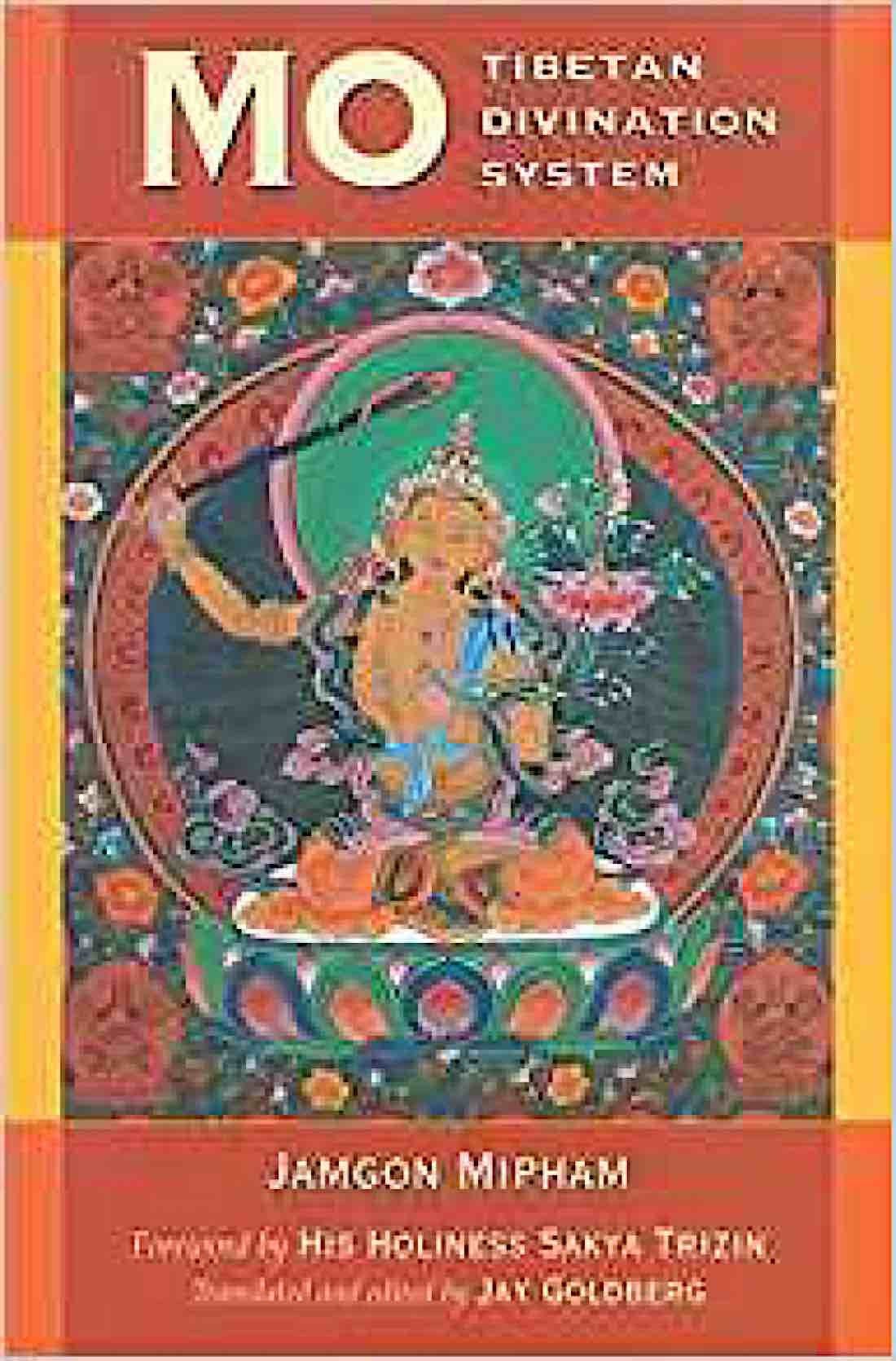
In the “West,” we might more commonly think of Tarot cards in this context. It’s easy to dismiss these as either superstition or just “fun” — which could be unfortunate. Mo dice, Mo Mala, I Ching, “temple divining bamboo sticks,” and Tarot may seem like “fun chance” — yet that overlooks their more profound aspects. There are even Buddhist Tarot Decks, such as Buddha Tarot by Robert Place (based on Vajrayana symbols) and Osho Zen, based on Zen meditation. [There is also a “Tarot as meditation” book by Zen chaplain Lisa Freinkel Tishman, PhD: Mindful Tarot.]
H.H. Sakya Trizin explains: “In Buddhism, especially in the Mahayana tradition, it has been taught that the highest good is to benefit other sentient beings… Since the Buddhas are endowed with knowledge of cause and effect of all conditions, as well as insight into their ultimate reality, the use of Mo could prove beneficial if combined with unwavering faith and one-pointed concentration upon the Buddhas. Mo is thus one of the ways in which unenlightened beings may rely upon the Buddhas to help overcome predicaments in their everyday life.” [1]
His Holiness goes on to explain that there are two functions of Mo:
- Everyday: “a system that allows us to help ourselves see a situation or event clearly.”
- As a giving act: “using Mo with proper motivation of performing a selfless act of giving — as has been extensively done by many great teachers of Tibet — it is a system that enhances our practice of the Bodhisattva’s path.”
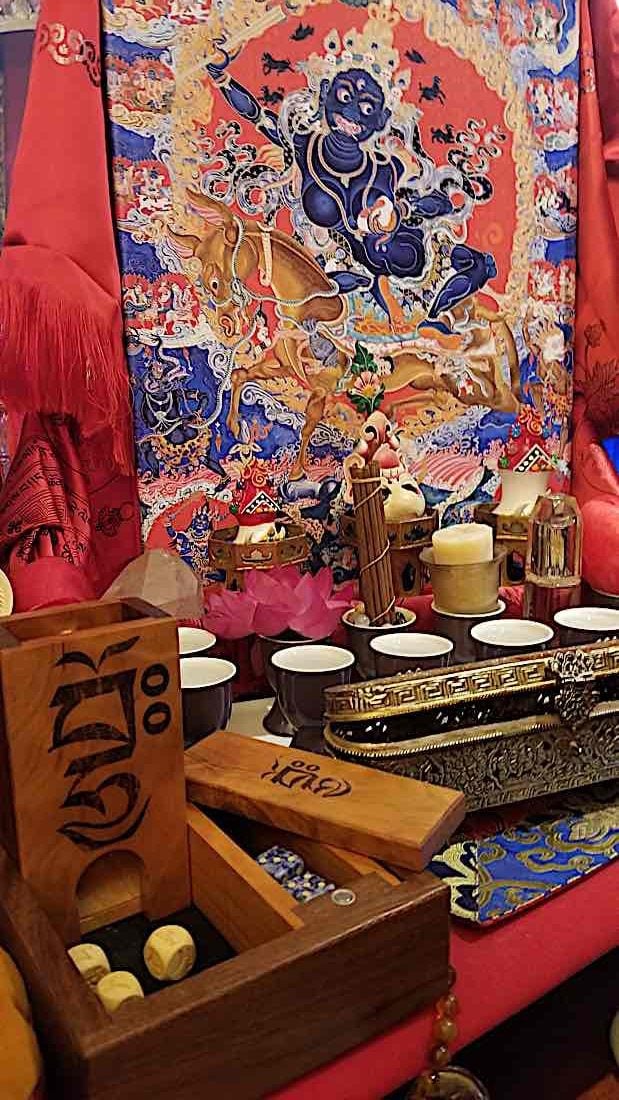
Pratiya Samutpada: Interdependent Arising is central to Mo
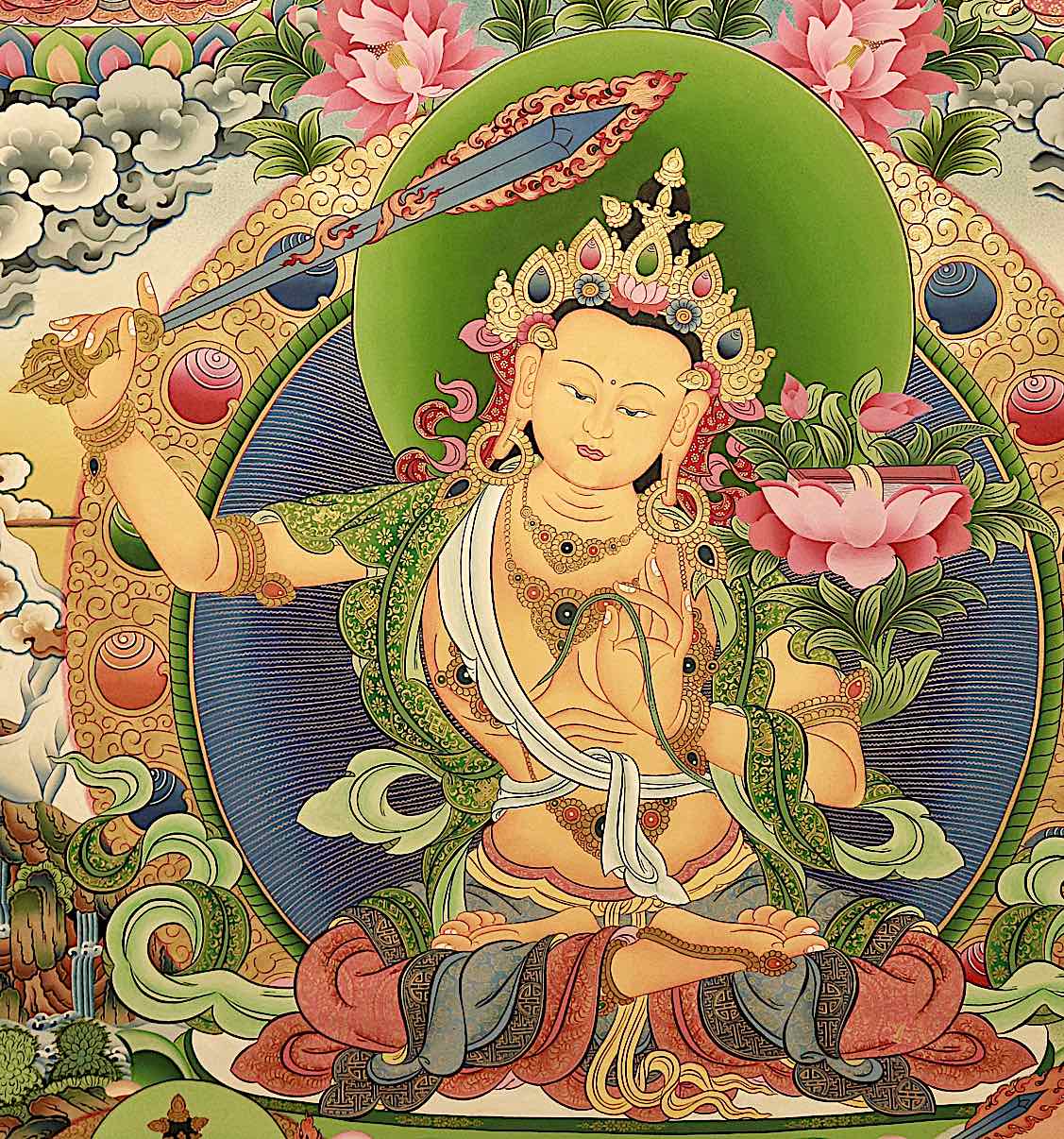
“Interdependent Arising… simultaneously explains the essence of the interplay of causes and conditions on the relative, worldly level of reality and the essence of Emptiness, or selflessness, on the ultimate level of reality,” explains H.H. Sakya Trizin
The doctrines of Interdependent Arising, and our understanding of the connectedness of all time and phenomenon — Shunyata — helps inform us of why Vajrayana Buddhist believe this to be an insightful practice, rather than a game of chance. When you do Mo, you praise first Manjushri, the Buddha of Wisdom:
“Om, the magnificent Manjushri who possesses the eye of transcendental wisdom which unobstructedly sees all three times, please take heed of me. Through the power of the truth of non-deceiving, interdependently arising Three Jewels and the Three Roots please make clear what should be accepted and discarded.”
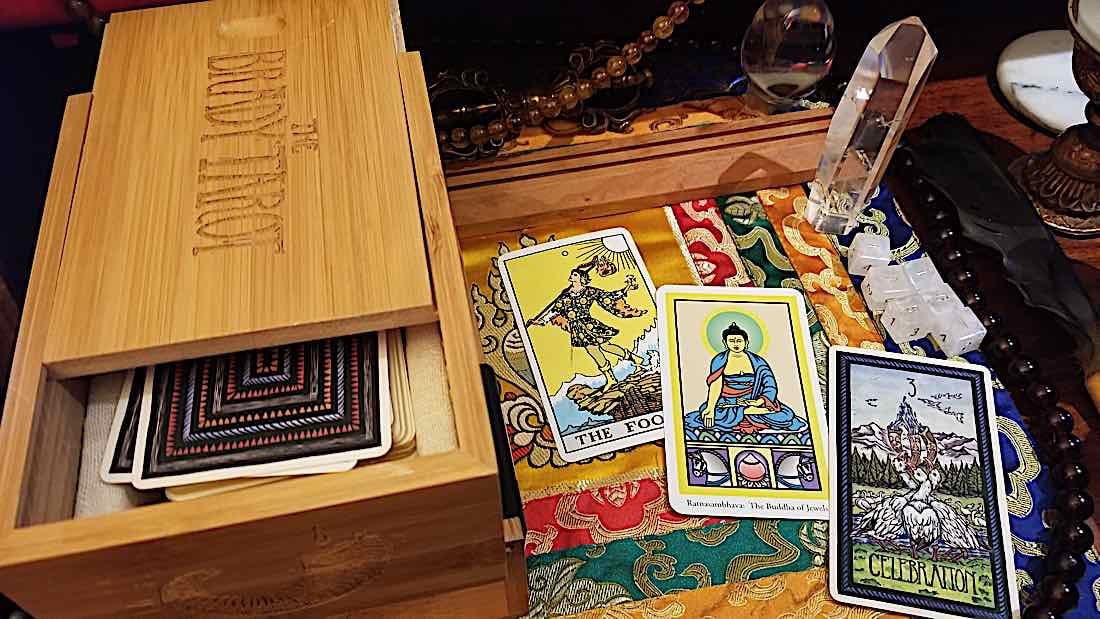
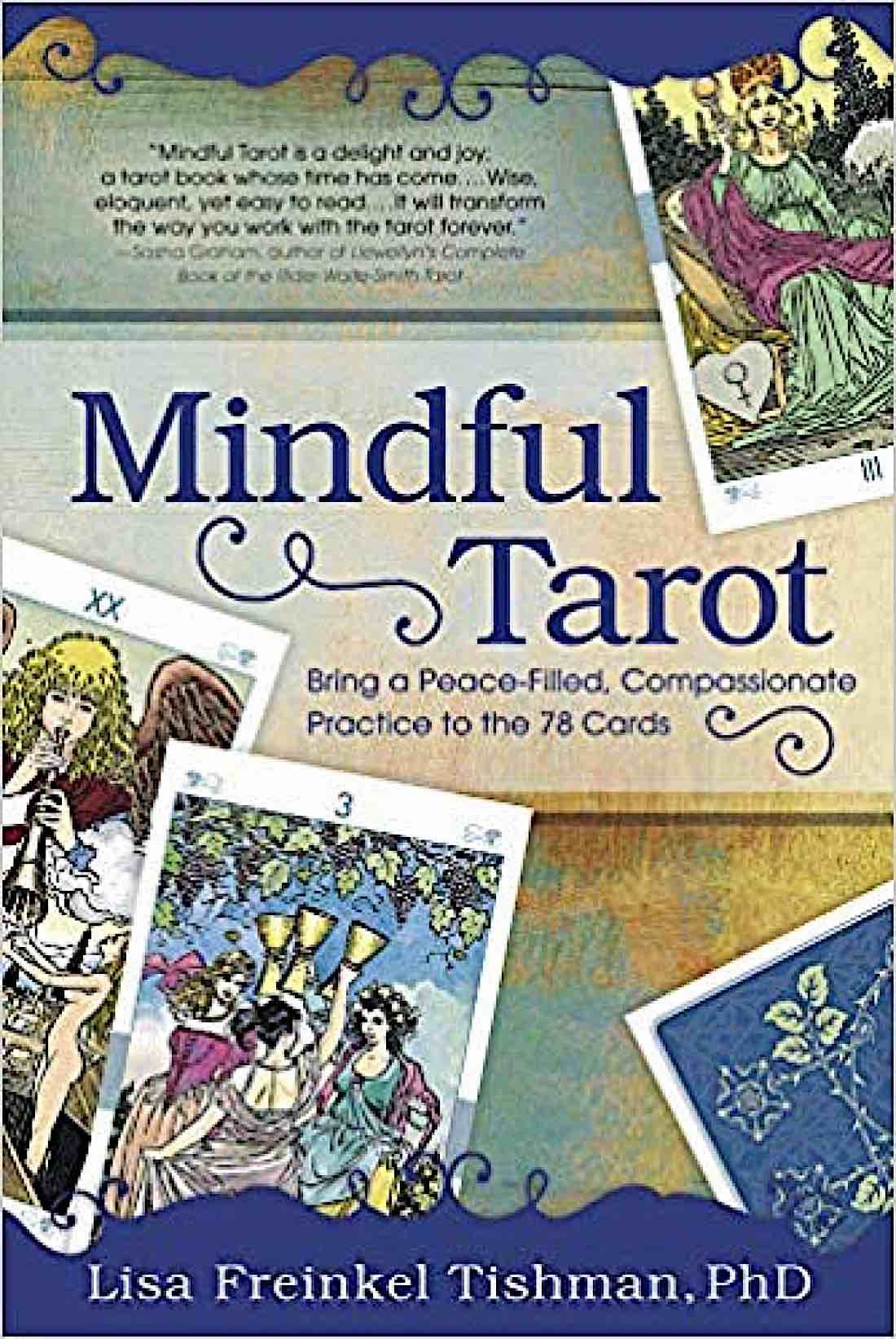
Buddhism is mostly a self-help path. Although we take Refuge, and have devotion for the Three Jewels of Buddha, Dharma and Sangha — we still have to do it all, even if we are fortunate enough to have a teacher. Buddhism isn’t about going to the temple on Sundays. As Gurus often say, “I can’t do your practice; only you can walk the path to Enlightenment for yourself.” We may have to go it alone but we can use various methods to work with our own minds. Meditation, of course, is the best known. Mo, is simply another method. Tarot, also, can be used as a method and certainly for guided meditation (although not as a lineage tradition.) (In part 2 of this series, we profile the book, Mindful Tarot: Bring a Peace-Filled, Compassionate Practice to the 78 Cards, by Lisa Freinkel Tishman, a Zen chaplain.)
Why are Mo and other methods important?
“Although diligent efforts are needed in concentration and insight to attain a realization of interdependent origination, a system such as Mo reveals a glimpse of interdependence and causal play of the world in which we live and may hopefully induce one to investigate it on a deeper level,” writes H.H. Sakya Trizin.
[For a quick Mo Dice How-to see the section below: “Mo — an easy how-to” based on the Mo Tibetan Divination System book from the great master Jamgon Mipham with a foreword by H.H. the Sakya Trizin.]
NOTE The Palden Lhamo methods, mentioned below, do require initiation and a teacher.
This is part 1 of a series. In Part 2 we look at “Western” Tarot as a non-traditional Buddhist method.
Mo is fun — it can also be profound
If purely fun, why do high Lamas frequently roll the Mo dice for laypeople? In Tibet, Mongolia, and Nepal, a layperson wouldn’t ignore the advice given by a Lama through the Mo divinations. H.E. Venerable Zasep Rinpoche, in a teaching retreat on Mo in Nelson B.C., told students how — whenever he goes to Mongolia — he makes sure he always have his Mo Dice bag. Every five minutes, someone will ask for advice via the Mo dice. He also told the story of how a recent Mo dice roll indicated where a Mongolian farmer should look for his missing herd. (They were found the next day in the direction the Mo indicated.) There are also countless stories of “helpful advice” from the shaking of the “bamboo sticks” at Mahayana temples.
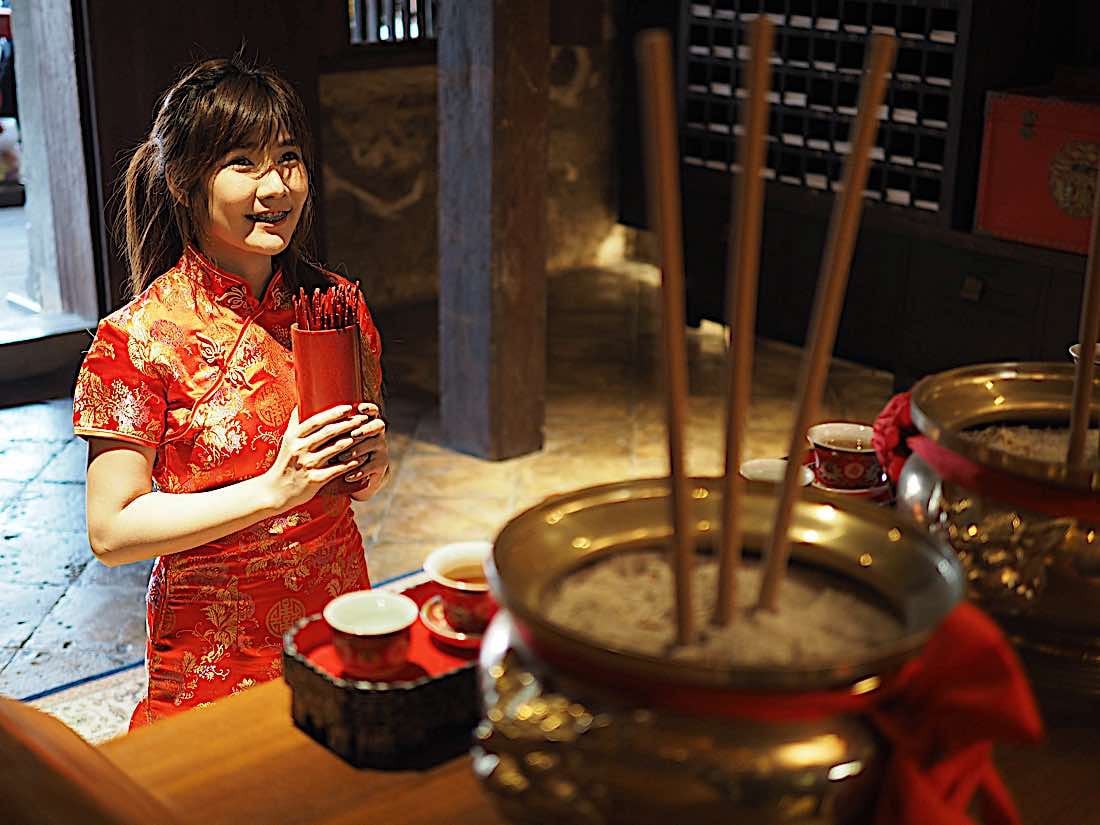
These stories may seem quaint, and we can easily dismiss them as irrational, yet those pre-prejudices don’t take into account the connection of Mo and Tarot (etc.) to the “Inner” or Subconscious Mind.
Whether you think of this as Buddha Nature (Mahayana), Higher Self, or just Mind, Mo and Tarot are valuable ways to communicate with either the Higher Self, or the intuitive self, which are not necessarily the same thing. Ultimately, of course, it can help us discover the illusory nature of “self.” Or, even, insight into Shunyata (Emptiness and Oneness of phenomenon.)
Divination is common in Buddhism
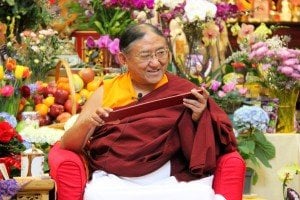
Although Mo doesn’t carry the old-testament stigma of Tarot cards — the old “Devil Cards” image is another unfortunate prejudice — Mo can still be rejected as superstitious, or misguided by the ultra rational and analytical. To do so is to misunderstand the true nature of Mo as a tool — especially in Vajrayana and Mahayana.
For those rationalists who reject “literal” devotion for the Three Jewels, you could say we are taking Refuge in those things within ourselves — our own Buddha Nature. This is a Mahayana teaching, of course. In earlier teachings, it might be thought of in psychological terms.
There are several psychiatrists and psychologists who use Mindful practice in therapy, without Buddhist connotations. Likewise, there are even psychologists who use Tarot cards as a “mind mirror” — to probe our own minds. Buddhism, like psychology, is very mind-focused. What is the nature of self and ego (or “non-self,” anatta)? Meditation — together with Mo, Tarot, and other divination tools — can be an effective way to help understand the true nature of mind — and therefore, the true ultimate nature of reality.
Shakyamuni Buddha certainly taught a self-motivated and practical path to Enlightenment, starting with the Four Noble Truths and the Eightfold Path. Through practices such as meditation and ethical standards that help us manage the “poisons” identified by the Buddha, we can walk the path to Enlightened Wisdom and Compassion.
Communicating with our Buddha Nature?
Yet there are other ways to connect with our Buddha Nature. Mo and other forms of divination are about communicating with Higher Self. To understand Mo, you have to embrace Dependent Arising and Emptiness. To gain insight from Mo, you also need Faith. Mo, just like meditation, is a form of embracing self-growth, Wisdom and Compassion. (Bear with me, I’ll explain why I believe this is the case.)
In some ways, you could say Mo works the same way as mindfulness. It helps focus and still the mind, allowing our inner wisdom to emerge. As with other forms of divination, Mo only works to the extent we enable it to work. Without the engine of Faith, the permission and training of a teacher, it may not be wise to rely on Mo.
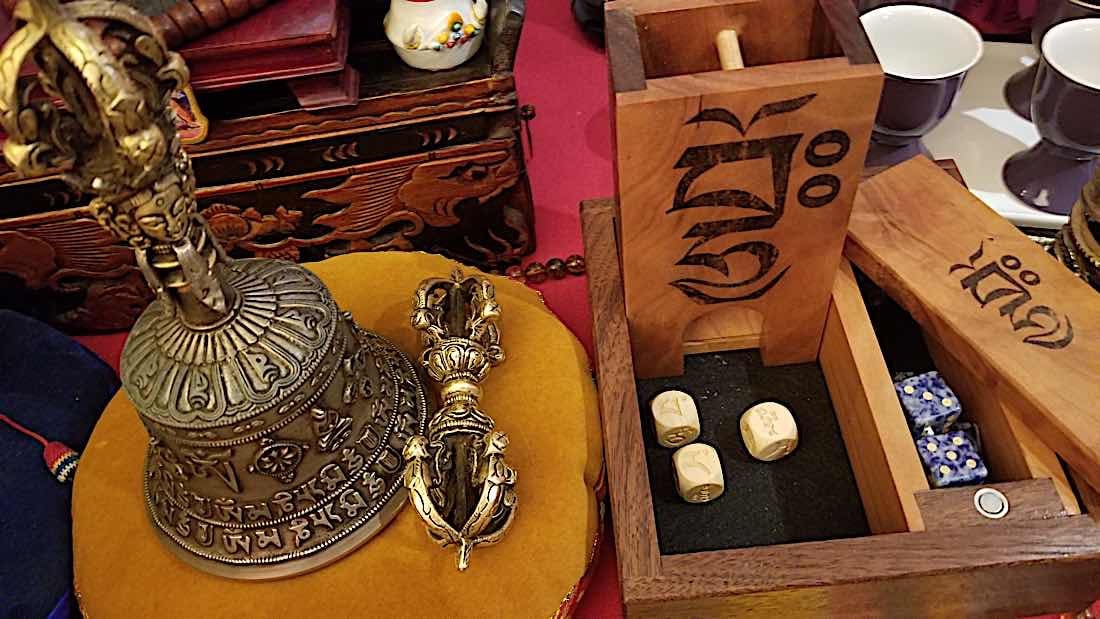
Certainly, roll the dice, learn and have fun; but, without requisite experience — usually a learning retreat from a knowledgeable teacher, plus authorized texts from realized teachers (which explain the meanings of the rolls) and faith in either one’s own Buddha Nature or the Meditational Deity (Yidam) — it would not be prudent to have blind belief in the Mo’s message.
For example, in Tibet, everyone may know how to roll Mo, and will often refer to them as a way to touch the Yidam (or inner Buddha Nature) — but if there is a passing teacher, they’ll be the first to run to ask for Lama’s Mo. As with any practice, experience, knowledge and faith are critical if you are planning on making life-decisions based on Mo.
Ultimately, Mo and Tarot are mind mirrors. You also have to make your own life decisions.
How do you know when to take Mo seriously?
The answer, if you practice, is — you always take it seriously. This is because, if your Lama throws the Mo, you must take it seriously. If you ask Manjushri or Palden Lhamo — you take it seriously. It doesn’t’ mean you’re obligated to follow the advice, but ignore it at your peril.
For serious Vajrayana Buddhists, to do Mo, you will have received initiations (Manjushri, Palden Lhamo, or other Enlightened Deities). You might then have completed a retreat and received instruction on Mo. You will have completed at least 100,00 mantras. However, in Tibet and other areas, where Mo is common, everyone knows Mo. Even without initiations — provided you only do Mo for yourself — it is common for everyone to “roll the Mo.”
Mo Divinations are always tied to Enlightened Deity practice. The vast majority of Mo systems are either focused on Manjushri — the Buddha of Wisdom — or Palden Lhamo, the Great Enlightened Protector of Tibet and the Dalai Lama.
With Manjushri Mo, it’s usually two dice with its own set of “advice” outcomes. Traditionally, the six sides are marked with the Tibetan syllables OM AH RA PA TSA NA DHI, although there is a method for using regular 1-6 dice. With Palden Lhamo, it’s always three dice, with a different system. In both cases, whether you have initiation or not, it is critical to only use divination outcomes from Tantra or lineage, written by a qualified teacher of known lineage.
If the practitioner follows lineage teachings, and takes Refuge in Enlightened deities, the Mo result should be taken very seriously. Whether you are communicating with Manjushri — or your Higher Self, or your Buddha Nature — which you can ultimately argue are all the same thing, you don’t ignore the Mo advice. You at least consider it seriously.
[For a quick How-to on Mo, see the last section.]
What about Tarot and other non-traditional methods?
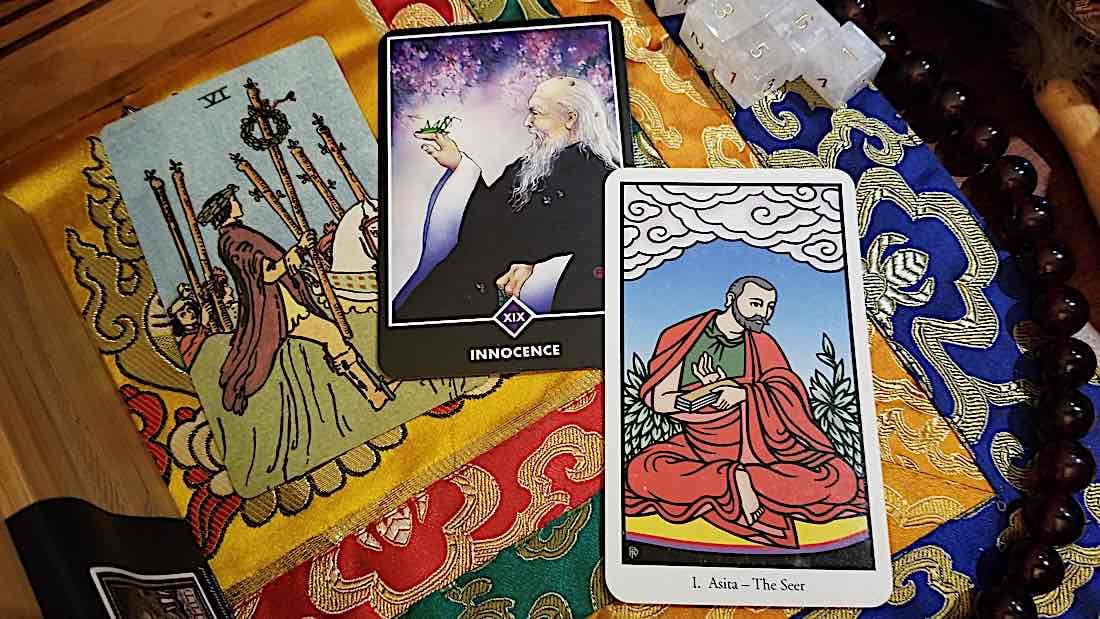
If you ask a Vajrayana teacher “Is it okay to use Tarot instead, I’m more used to it” they are likely to shrug and say something like “I don’t know Tarot, I can’t speak to that.”
Mo is a lineage teaching in Vajrayana Tibetan Buddhism. If, however, you enjoy Tarot, or another “mind mirror” method, there is certainly no harm in using them instead, especially if you are a “westerner.” The archetypes and symbols in Tarot can are more immediately familiar to people born in the “West.” For instance, the “scales of justice” as a symbol — very much based on Western esoteric symbolism.
In Buddhism, even when you have a root Guru, you still must be self-guided. If you choose to add to insights through Tarot and non-traditional methods, no one can criticize, especially if this is a symbolic area of familiarity for you.
Mo — an easy, how-to
Personally, I have three Mo texts, two from separate lineage teachers in the Palden Lhamo system, and the publicly-available text Mo Tibetan Divination System book from Jamgon Mipham with a foreword by H.H. the Sakya Trizin. This quick how-to is based on the system in this book, since the Palden Lhamo methods are more complex, with more layers of divination based on purpose, and they require the permission of a teacher.
Even with the Mo system here, this is only for personal use. If you plan on giving advice to other people, the great master Jamgon Miphan advises you should have completed Manjushri retreat and at least 100,000 mantras. If you are really interested, you will need a die (or dice), and ideally, you should buy the small book from Jamgon Mipham. (Here, on Amazon, if you are interested>>)
Purpose is important
The way the question is phrased is critical. It is best to ask the question as “advice” rather than as a prediction. Don’t ask “yes” or “no” questions. (Will I win the lottery?” won’t work. Remember the answer will be one of “very good outcome,” “good outcome,” “mediocre outcome,” “bad outcome,” or “very bad outcome.” Depending on your question, you could read this as “good chance, bad chance” and so on.
In other words, rather than:
“Should I follow my partner’s advice for a solution to… ?”
Ask
“Is I follow my partner’s advice, what will be the result?”
If the answer is “very bad” you can ask your second option. If you have no other options, the Mo provides “Remedies” which might include donating to charity, making offerings, or practicing more Medicine Buddha sadhanas (as examples. The remedy list is quite long.)
Typically, the answers are longer than one paragraph, not one word, and you could categorize them into:
- Very good
- Mediocre (good)
- Bad
- Very bad
- But there’ll be a lot more answer, depending on whether your question is
- Spiritual
- Family
- Goal-oriented
- Wealth-oriented
- Friend or enemy
- Guests
- Illness
- Lost article (a common use of Mo in Tibet, for example)
- All remaining matters
Within that, depending on the category of question, there are substantial nuances — including different answers if you are a monk or Yogi-Yogini versus an ordinary lay-person. It is amazing how the answer is a tight fit for your question (in my experience, anyway.)
Meditation first
All Mo practices begin with meditation. Usually, it’s best to undertake at least 10 minutes of mindfulness or focus on the breath. Relax and open.
If you plan to read regularly, it is best to have a dedicated die or dice. Keep them in your sacred area. Handle them while you chant mantras. Blow on them after you recite all your mantras. Treat them as special.
Then, the meditation continues, this time with a visualization — which is a proven method to engage the mind.
In this case, with Manjushri Mo, the great Jamgon Mipham instructs:
“Imagine the great Bodhisattva of Wisdom, Manjushri, is in the sky in front of you. His body is yellow, with one face and two hands. His right holds aloft the flaming sword of wisdom, while his left-hand holds at his heart the stem of a blue lotus flower… The flower blossoms beside his left ear, and upon it rests a copy of The Sutra of the Perfection of Wisdom (Prajnaparamita). His two feet are crossed in the vajra posture and he appears in the form of a sixteen-year-old boy. Thinking that he is blessing the dice with which you are going to make the prediction, recite the following verse:
“Om, the magnificent Manjushri who possesses the eye of transcendental wisdom which unobstructedly sees all three times, please take heed of me. Through the power of the truth of non-deceiving, interdependently arising Three Jewels and the Three Roots please make clear what should be accepted and discarded.”
Next you should recite the mantra of Manjushri as many times as you can (and blow on the dice when completed):
OM AH RA PA TSA NA DHI
You should also recite the mantra of Interdependent Origination:
OM YEDHARMA HETU PRA-PHAWA HETUNTE KHEN TA THAGATO HAYA WATET TE KHEN TSAYO NIRODHA EWAM WADI MAHA SHRAMANA SOHA.
Then say:
The Tathagata has explained the origin of these things which arise from a cause; their cessation too he has explained; this is the doctrine of the Great Sage.
Typically, you would blow on the dice, close your eyes, visualizing Manjushri in all his glory, ask the question quietly, then throw the die (or dice) — usually, as is recommended in the teachings, into a box.
With Manjushri Mo, you’ll need the result from two dice. You can roll one die at a time, or two at once. You add the two together and interpret the answer based on the pre-written “answers” in the Mo text — first choosing your category.
If you plan on undertaking Mo, it is desirable to find Jamgon Mipham’s book, Mo: Tibetan Divination System. In the book, each result has a various associations, a poem and then answers that are specific to categories. A “six” rolled may mean entirely different things if the question is about family, versus illnesses. For that reason, as the text is concise, but precise. It is too long to synopsize here; the book is recommended.
- In a future instalment, if there is interest, we may try to list some of the “answers” and “remedies.”
- In Part 2, we look at “Western” Tarot as a Buddhist method.

NOTES
[1] From “Foreword” to MO: Tibetan Divination System translated by Jamgon Mipham.
- Paperback: 160 pages
- Publisher: Snow Lion; Revised ed. edition (May 2 2000)
- Language: English
- ISBN-10: 1559391472
- ISBN-13: 978-1559391474
4 thoughts on “Mo Dice and Mo Mala, Bamboo Sticks, and other “divinations” — “Mo could prove beneficial…” HH Sakya Trizin”
Leave a Comment
More articles by this author
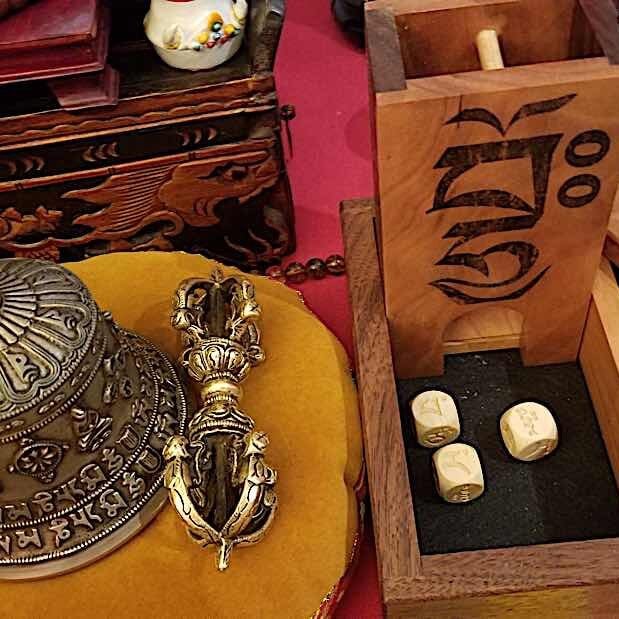
Mo Dice and Mo Mala, Bamboo Sticks, and other “divinations” — “Mo could prove beneficial…” HH Sakya Trizin
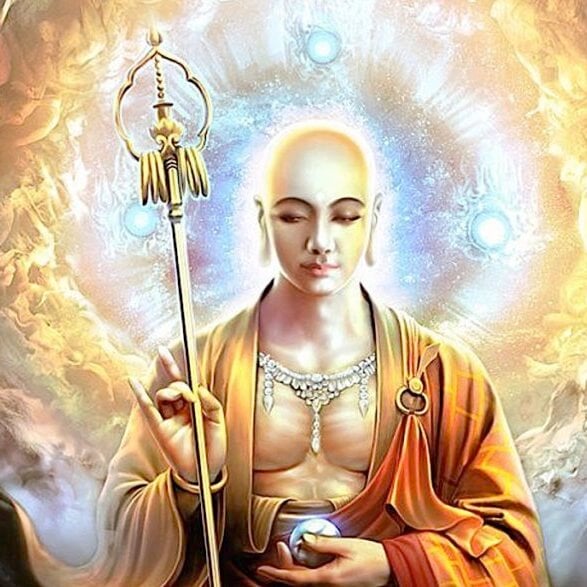
Lama Zopa Rinpoche and other teachers recommend Kṣitigarbha mantra and practice for times of disaster, especially hurricane and earthquake, because of the great Bodhisattva’s vow

50 Songs of Milarepa and the Grand Epic Story of Mila the Cotton Clad: Murder, Evil, Revenge, Redemption, Ordeals, Doing What’s Right
Search
Latest Features
Please support the "Spread the Dharma" mission as one of our heroic Dharma Supporting Members, or with a one-time donation.
Please Help Support the “Spread the Dharma” Mission!

Be a part of the noble mission as a supporting member or a patron, or a volunteer contributor of content.
The power of Dharma to help sentient beings, in part, lies in ensuring access to Buddha’s precious Dharma — the mission of Buddha Weekly. We can’t do it without you!
A non-profit association since 2007, Buddha Weekly published many feature articles, videos, and, podcasts. Please consider supporting the mission to preserve and “Spread the Dharma." Your support as either a patron or a supporting member helps defray the high costs of producing quality Dharma content. Thank you! Learn more here, or become one of our super karma heroes on Patreon.
Josephine Nolan
Author | Buddha Weekly
Josephine Nolan is an editor and contributing feature writer for several online publications, including EDI Weekly and Buddha Weekly.





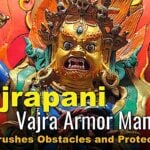
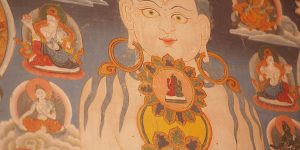









Does a person need empowerment to use mo divination?
The lineage teachings (that I know of) recommend empowerment if you are doing Mo for other people. In Tibet, almost everyone (slight exagerration, but certainly in the “old days”) did Mo for themselves. However, even for self-practice, where you’re not advising others, they recommend empowerment of the deity you are appealing to in your Mo (i.e. Manjushri, or Palden Lhamo). Then, if you are serious, a 100,000 mantra retreat, etc, followed by Fire Puja. But, this is for people who are very serious about Mo. If it’s just for yourself, and bearing in mind Empowerment makes the practice more insightful, you don’t have to. However, you can really only obtain Manjushri two-dice Mo methods as a published non-restricted text. The Palden Lhamo is generally a restricted text. Without that text, you can’t practice Mo, since the “answers” are in that text. It’s a lovely, insightful, useful, devotional and enjoyable practice. In kindness, Lee
Hello Lee, I hope you are well.
I have wondered about the Manjushri Mo system for years having been shown a simple form by Lama Zopa many years ago. Does the book you are recommending explain more about the mala approach as well as the dice? Also are there different divination explanations?
I would love to know.
Meanwhile I trust all is well. The Buddha Dharma magazine seems to be flourishing.
Very best wishes
Rob
Dear Rob, Nice to hear from you! I actually don’t think the mala mo is in that lovely book (it’s a small book, quite handy, but it’s dice mo.) It’s a little unique in that you use Seed syllables from om ah ra pa cha na Dhi (forgive my phonetics) on the dice in the place of the typical eyes for numbers.) I also have from several teachers Palden Lhamo Mo (one system from the Third Dalai Lama) which I have as a PDF — we’re going to cover it in future, but it is meant to be used by Palden Lhamo pratitioenrs.
For the mala, it’s simple method, and has the great virtue of being something we carry with us every day — but to be useful you have to have a question in mind because whether the results — Falcon, raven or snow lion — is good or bad depends on the question. It should always be a 108 mala for this — but I do find the Mo die are more elaborate and helpful personally.
For the mala method (we’ll elaborate in the series carry on feature) (below is from Sakya — there’s also a separate method, specifically for Green Tara):
You visualize the deity Manjushri (or your own Yidam if you have a strong practice of one particular yidam) and pray one full round (at least) of the mantra (Manjushri mantra or your Yidam). The person doing the divination prays to the deity he is invoking for the correct answer and recites that deity’s mantras. He then holds up the rosary horizontally in front of him, with the fingers of each hand grasping a randomly chosen bead, leaving half the beads of fewer between them. Then the fingers of each hand move towards each other counting three beads at a time. The outcome of the divination depends on the number of beads left. The procedure is repeated three times.
When only one bead remains, the result is called `falcon’.
When two beads remain, it is called ’raven’.
When three beads remain the result is called ’snow lion’.
The outcome on the first attempt indicated the extent of the deities’ support and the quality of the divination in general. A falcon at the first attempt would indicate support from protectors, luck in a new enterprise, success in a lawsuit.
A raven on the first try means the protectors are not on your side. There will be no accomplishment, or even that there are enemies present.
A snow lion on the first round would indicate support from the deities, slow but stable accomplishments and weakness on the part of enemies. If the question concerned successful business, this would be regarded as a neutral result.
At the second attempt, the outcome indicates conditions to take place in one’s immediate environment. The falcon indicates good luck in general, but not much success for those wishing to have children. The risk of thefts and illnesses in general would remain small. The raven indicates serious illness, obstacles to health and a decline in the life force. There will be a tendency for things to get lost or stolen. However, in the case of an ordained person, these negative aspects would be reduced.
On the third occasion, the number of remaining beads gives clues about an expected person arriving from elsewhere. This was a very important aspect of life in Tibet, for people traveled constantly and there was no communication system. A falcon with regard to an expected visitor indicates imminent news or arrival. With regard to illness, it would indicate finding the best way to cure it.
A raven represents a bad indication concerning expected travelers. They are likely to encounter obstacles on the way will not arrive at all or will be robbed. The sick will not be cured and possessions will be lost or stolen. The snow lion indicates that travelers will arrive late, but come to no harm. Problems with health will be few, although there will be difficulties in finding the right treatment.
The best divination would be three consecutive falcons. This would indicate that travelers will arrive quickly, patients will recover and accomplishments will be swift, etc.
We’ll elaborate on it in our next feature in this series.
Very nice to hear from you Rob! Happy Saga Dawa!